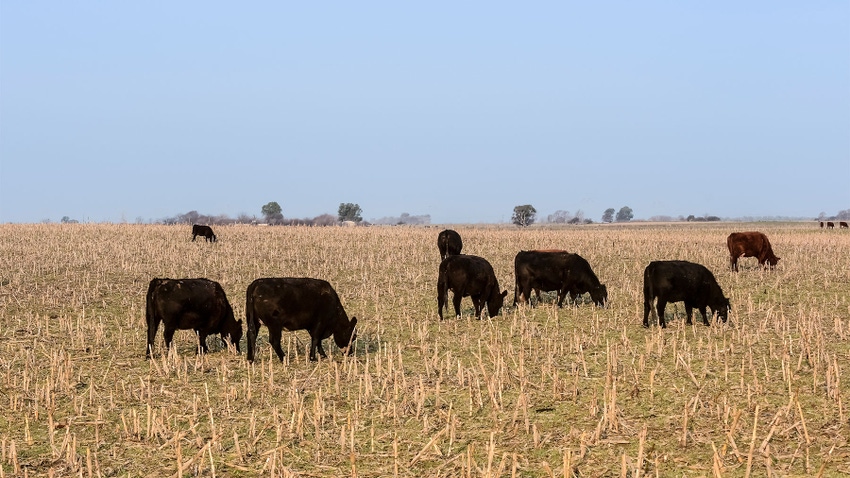October 10, 2023

by Tara Felix
While corn residue can provide additional grazing days to a beef operation, there are factors that must be considered to optimize the use of this residue.
The nutrients in corn residue can vary depending on the part of the plant animals will graze. Using managed grazing strategies can force cattle to consume a more uniform diet and improve their use of residue.
For example, if given access to an entire cornfield, the cows will eat any grain in the field first, followed by the husk and leaf — which are more palatable than stalks — and finally the cob and stalk. A technique such as strip grazing, which is a managed grazing system that involves giving livestock a fresh allocation of forage that is usually controlled using an electric fence, can improve results if cattle are not forced to eat cobs and stalks.
Here are four factors to consider if you’re planning to graze cattle on corn residue:
1. Weather is the wild card. Weather is often the major factor determining the actual number of grazing days.
Grazing residue works great after corn harvest up until winter weather starts kicking in. In fact, most beef cows can successfully graze corn residue that has 4 to 6 inches of snow cover. However, cattle will not be able to graze fields that are ice covered.
In theory, as many as 120 grazing days are possible, but it could be just as likely that you’ll get only 45 days before bad weather stops grazing altogether. Because of this, it is important to have an emergency feed supply, such as hay or silage.
2. Manage for growth stage. Managing corn residue for specific classes of cattle can be beneficial.
For example, spring-calving cows grazing corn residue will have sufficient energy and protein to meet their requirements in mid-gestation.
Dry cows should easily maintain body weight, and may even gain weight, eating corn residue because this residue supplies sufficient nutrients for this production stage.
On the other hand, first-calf heifers, especially 90 days before calving, will need protein and energy supplements to meet nutrient requirements. Feeding 3.5 pounds of whole soybeans, 4.5 pounds of dry brewers grains or 3.5 pounds of dried distillers grains per head per day on a dry matter basis would meet this need.
Salt, mineral and vitamin A supplements are recommended for all cattle grazing crop residue.
Fall-calving cows will also need additional protein and energy to meet their nutrient requirements, especially in the first three months after calving. These cows will need 4.5 pounds per day of a supplement that is at least 30% protein and 90% total digestible nutrients (TDN) on a dry matter basis, in addition to the corn residue they are grazing. Feeding 6 pounds of dry brewers’ grains or 5 pounds of DDGS per day would also meet this need.
Spring-born calves weaned in fall can also be grown on corn residue. Research has shown that DDGS fed at 2 pounds per day when calves are grazing corn residue will usually meet protein requirements to achieve 1 pound of daily gain. Feeding whole soybeans at 2.5 pounds per day or dry brewers grains at 3 pounds per day will meet the same requirements.
3. Look at what’s out there. It is important to scout fields before grazing to determine the amount of corn present and to look for piles that could cause grain overload, which can result in bloat or cattle death.
If there are more than 8 to 10 bushels of corn per acre on the ground, a grazing strategy such as strip grazing to control corn intake is crucial.
It is also crucial to recognize variations in residue quality. While the quality of corn residue may start at about 70% TDN, it will decrease to as low as 45% TDN by the end of the grazing period. The rate of quality decline is dependent on stocking rate and environmental factors like moisture, precipitation and field conditions.
Because of these environmental factors, it is better to let cows graze during the first months after harvest — October, November, December — than in January or February.
4. Calculate stocking density. Calculating an adequate stocking density is also important. The amount of grain, husk and leaf available per animal will define stocking density and directly affect diet quality as these plant structures are highly digestible.
Grazing days and stocking density can be determined using the estimate of 50% utilization of the leaf and husk to maintain residue on the field. You must also consider that some residue will disappear through trampling and other factors.
Therefore, 160-bushel corn can produce 2,560 pounds — 160 bushels an acre × 16 pounds per bushel — of leaf and husk per acre. Half of that — 1,280 pounds of husk and leaf — is available for the animal to consume. This would be equal to 1.88 animal unit months, or 1,280 pounds of husk and leaf per acre at 50% use divided by 680 pounds of feed per AUM.
One AUM is the amount of forage required to sustain a 1,000-pound cow or equivalent for a month, and it has been determined that a 1,000-pound cow will consume 680 pounds of dry matter monthly.
This same acreage could provide feed for a 1,000-pound cow for 56 days.
It's important to mention that cob and stalk won't meet nutrient requirements of the late-gestating cow, and it would lose weight if kept in the field for a few more weeks.
Corn residue grazing is a viable and economical option for late fall and early winter, and when supplemented with a byproduct can help keep winter feed costs low.
Felix is an Extension beef specialist with Penn State Cooperative Extension.
Source: Penn State Cooperative Extension
Read more about:
BeefYou May Also Like




